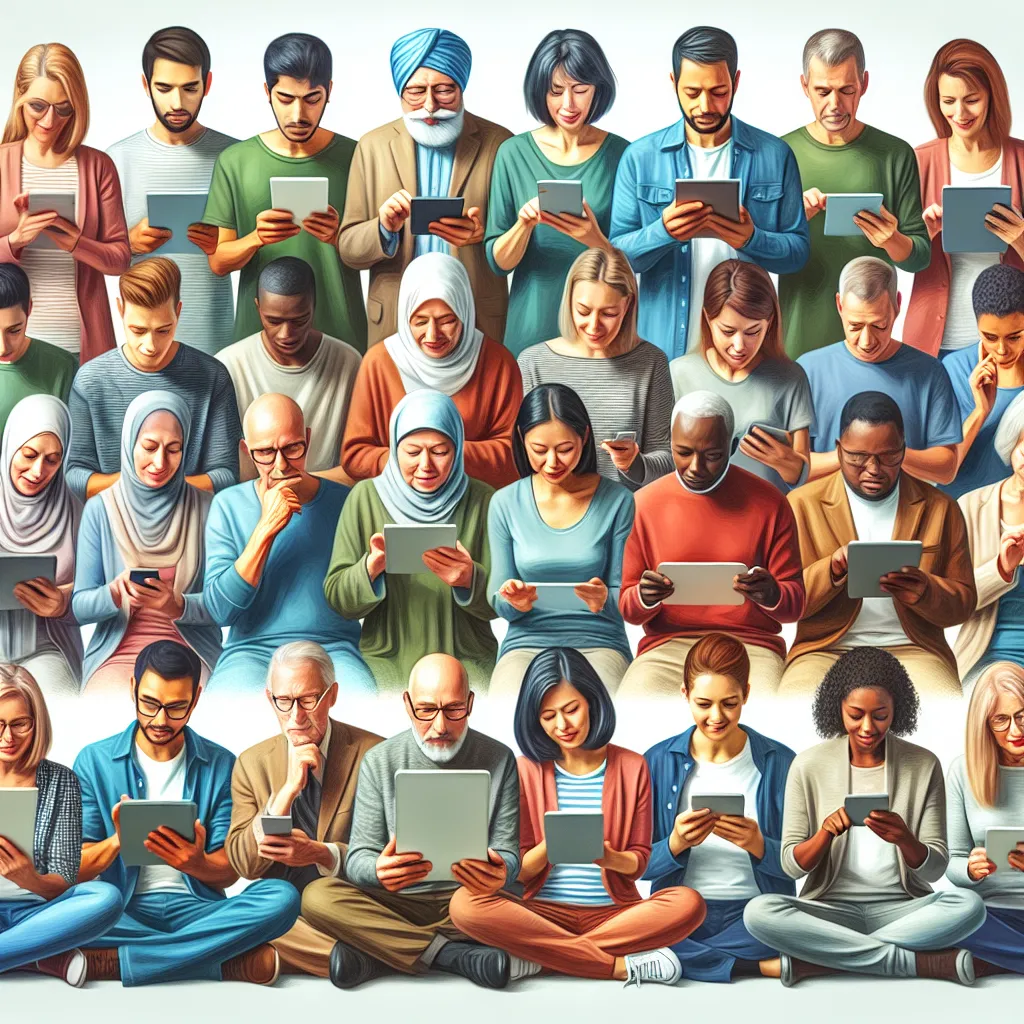The IELTS Reading section is a crucial component of the test, assessing your ability to comprehend complex texts and extract relevant information. Today, we’ll focus on a topic that has become increasingly important in our modern, fast-paced world: “How to stay connected with family and friends.” This theme has been a recurring subject in IELTS exams, particularly in recent years as global events have highlighted the significance of maintaining strong personal relationships despite physical distances.
Based on analysis of past IELTS exams and current societal trends, it’s highly likely that this topic will continue to appear in future tests. The ability to discuss methods of staying connected and the impact of technology on relationships is not only relevant for the exam but also for real-life situations. Let’s dive into a practice reading passage on this subject to hone your skills and prepare for potential questions in your upcoming IELTS exam.
Reading Passage
Bridging the Distance: Modern Ways to Stay Connected with Loved Ones
In today’s globalized world, maintaining close relationships with family and friends has become both more challenging and more accessible than ever before. With people often living and working in different cities or even countries, the traditional methods of staying in touch have evolved dramatically. This shift has been further accelerated by recent global events, forcing individuals to find innovative ways to bridge the physical gap and maintain emotional connections.
The digital revolution has played a pivotal role in transforming how we communicate and stay connected. Social media platforms, instant messaging apps, and video calling services have become ubiquitous tools in our daily lives. These technologies offer real-time communication, allowing people to share moments, thoughts, and experiences instantly, regardless of geographical barriers. For instance, grandparents can now watch their grandchildren’s first steps through video calls, or friends can participate in virtual game nights despite being continents apart.
However, the ease of digital communication has also raised concerns about the quality of these interactions. While it’s now possible to be constantly connected, many argue that the depth of these digital exchanges often falls short of face-to-face interactions. The challenge lies in finding a balance between the convenience of modern technology and the richness of personal, physical connections.
 Staying Connected in the Digital Age
Staying Connected in the Digital Age
To address this, many individuals and families are adopting creative approaches to stay meaningfully connected. Virtual dinner parties, online book clubs, and collaborative digital projects have emerged as popular ways to create shared experiences despite physical separation. These activities not only facilitate communication but also help maintain a sense of togetherness and shared purpose.
Moreover, the importance of non-digital methods should not be overlooked. Traditional forms of communication, such as letter writing and sending care packages, have seen a resurgence. These tangible expressions of care offer a personal touch that digital methods sometimes lack, providing a sense of nostalgia and intimacy that many find comforting in an increasingly digital world.
Mental health experts emphasize the crucial role of maintaining strong social connections for overall well-being. Regular communication with loved ones can reduce feelings of isolation, lower stress levels, and provide emotional support during challenging times. This has become particularly evident during periods of enforced separation, highlighting the resilience and adaptability of human relationships.
As we navigate this new landscape of connection, it’s clear that the key lies in leveraging both traditional and modern methods of communication. By combining the immediacy of digital technology with the depth of more traditional forms of interaction, individuals can create a rich tapestry of connections that span distances and withstand the test of time.
In conclusion, staying connected with family and friends in the modern era requires a multifaceted approach. It involves embracing new technologies while not losing sight of the value of more traditional forms of communication. As our world continues to evolve, so too will our methods of maintaining these vital connections, ensuring that distance remains merely a physical concept, not an emotional one.
Questions
True/False/Not Given
For questions 1-5, read the following statements and decide if they are True, False, or Not Given based on the information in the passage.
- Social media and video calling have completely replaced traditional methods of communication.
- Virtual dinner parties and online book clubs have become popular ways to create shared experiences.
- Mental health experts suggest that maintaining social connections can help reduce stress levels.
- Letter writing and sending care packages are no longer considered effective ways of staying connected.
- The passage suggests that a combination of digital and traditional communication methods is ideal for maintaining relationships.
Multiple Choice
Choose the correct letter, A, B, C, or D for questions 6-10.
-
According to the passage, what has made staying connected with loved ones more challenging?
A) Lack of internet access
B) High costs of communication
C) People living and working in different locations
D) Time zone differences -
Which concern is raised about digital communication in the passage?
A) It’s too expensive
B) It lacks the depth of face-to-face interactions
C) It’s not accessible to everyone
D) It’s too time-consuming -
What is mentioned as a benefit of traditional forms of communication like letter writing?
A) They are faster than digital methods
B) They are more environmentally friendly
C) They offer a personal touch that digital methods may lack
D) They are more reliable than digital communication -
According to the passage, maintaining strong social connections is important for:
A) Career advancement
B) Physical fitness
C) Overall well-being
D) Academic success -
The passage suggests that the future of staying connected will likely involve:
A) Exclusively using digital methods
B) Returning to only traditional forms of communication
C) A combination of digital and traditional methods
D) Developing entirely new forms of communication
Matching Headings
Match the following headings (A-F) to the paragraphs (11-14) in the passage. There are more headings than paragraphs, so you will not use all of them.
A) The Rise of Digital Communication
B) Balancing Technology and Personal Touch
C) The Importance of Social Connections for Mental Health
D) Challenges of Long-Distance Relationships
E) Creative Approaches to Virtual Togetherness
F) The Future of Communication Technologies
- Paragraph 3
- Paragraph 4
- Paragraph 5
- Paragraph 6
Answer Key and Explanations
True/False/Not Given
- False – The passage states that traditional methods have evolved, not been completely replaced.
- True – This is explicitly mentioned in paragraph 4.
- True – This is stated in paragraph 6.
- False – The passage mentions a resurgence in these traditional methods.
- True – The conclusion clearly suggests this combination.
Multiple Choice
- C – The passage mentions people living and working in different cities or countries as a challenge.
- B – The passage discusses concerns about the depth of digital interactions compared to face-to-face.
- C – The passage states that traditional methods offer a personal touch that digital methods sometimes lack.
- C – Mental health experts emphasize the importance of connections for overall well-being.
- C – The conclusion suggests a multifaceted approach combining both digital and traditional methods.
Matching Headings
- B – This paragraph discusses the balance between digital convenience and personal connections.
- E – This paragraph describes creative approaches like virtual dinner parties and online book clubs.
- B – This paragraph talks about combining digital and non-digital methods of communication.
- C – This paragraph focuses on the importance of social connections for mental health and well-being.
Common Mistakes to Avoid
- Overlooking key phrases: Pay attention to qualifying words like “some,” “many,” or “often” which can change the meaning of a statement.
- Making assumptions: Stick to the information provided in the passage and avoid drawing conclusions based on personal knowledge.
- Misinterpreting “Not Given”: Remember, this option means the information is neither confirmed nor contradicted in the text.
- Rushing through the passage: Take time to understand the overall structure and main ideas before answering questions.
- Ignoring context: Consider the surrounding sentences when determining the meaning of a particular statement.
Key Vocabulary
- Ubiquitous (adjective) /juːˈbɪkwɪtəs/ – present, appearing, or found everywhere
- Pivotal (adjective) /ˈpɪvətl/ – of crucial importance in relation to the development or success of something else
- Resurgence (noun) /rɪˈsɜːrdʒəns/ – an increase or revival after a period of little activity, popularity, or occurrence
- Tangible (adjective) /ˈtændʒəbl/ – perceptible by touch; clear and definite; real
- Multifaceted (adjective) /ˌmʌltiˈfæsɪtɪd/ – having many different aspects or features
Grammar Focus
Pay attention to the use of present perfect tense in the passage, e.g., “has become,” “have emerged.” This tense is used to connect past events or states to the present, which is particularly relevant when discussing ongoing trends or changes in communication methods.
Example: “The digital revolution has played a pivotal role in transforming how we communicate and stay connected.”
Practice: Try creating your own sentences using the present perfect tense to describe changes in how you or others stay connected with family and friends.
Tips for Success in IELTS Reading
- Time management: Allocate your time wisely between reading the passage and answering questions.
- Skim and scan: Quickly skim the passage for main ideas, then scan for specific details when answering questions.
- Use context clues: If you encounter unfamiliar words, try to deduce their meaning from the surrounding context.
- Practice regularly: Familiarize yourself with various question types and develop strategies for each.
- Read actively: Engage with the text by underlining key points or making brief notes.
- Don’t leave blanks: Even if you’re unsure, always provide an answer as there’s no penalty for incorrect responses.
Remember, improving your reading skills takes time and consistent practice. Regularly exposing yourself to a variety of English texts on different topics will help build your comprehension skills and vocabulary, both of which are crucial for success in the IELTS Reading section.
By focusing on passages like “How to stay connected with family and friends,” you’re not only preparing for a potential IELTS topic but also enhancing your understanding of an important aspect of modern life. Keep practicing, and you’ll see improvement in both your test performance and your overall English language proficiency.
For more practice on related topics, you might find these articles helpful:
- The Impact of Technology on Interpersonal Communication
- How Social Media Affects Mental Health During Crises
- The Importance of Digital Literacy for the Elderly
These resources can provide additional context and vocabulary related to communication and technology, further enhancing your preparation for the IELTS Reading test.


